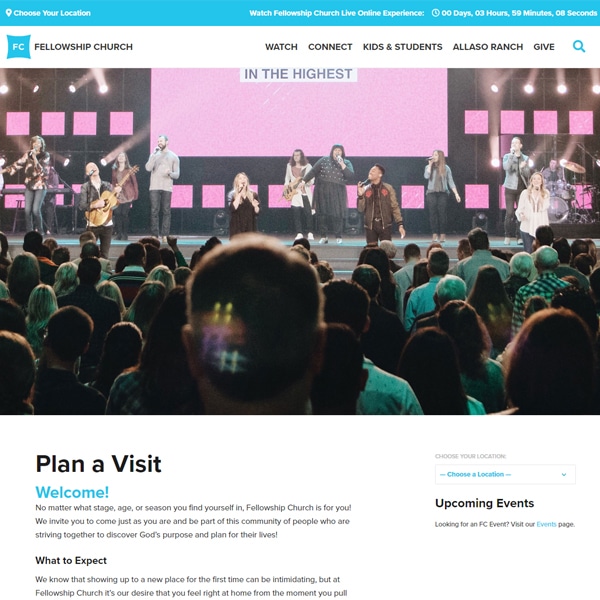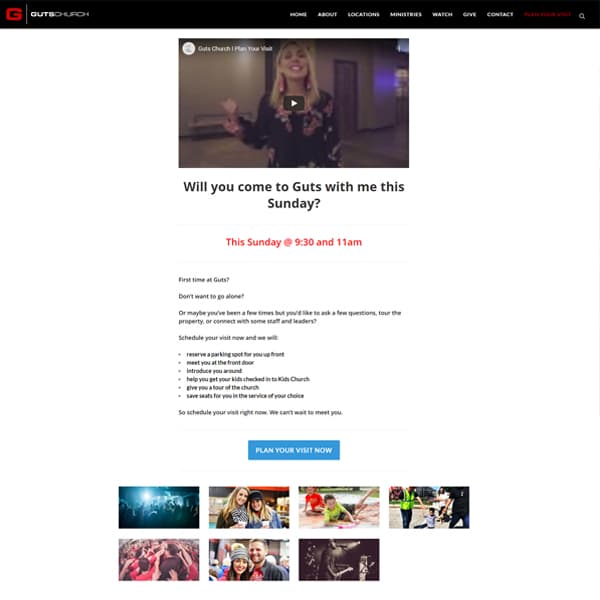The early Church, by design, was home-based and by its very nature, welcoming and hospitable.
As churches became organized, modern church found a new challenge: to not become just a building but a people of God that happened to meet. Inevitably, technology became both the problem and the new solution for making real connections.
For many people, your website will be their first introduction to your church. Think of it as your virtual welcome mat.
Whether they are looking for you deliberately or just searching for churches in the area, many people will find your website—whether organically or through paid ads—long before they set foot in your building.
In fact, a study by Grey Matter Research found that
“in the last 12 months, over 17 million American adults who don’t regularly attend worship services visited the website of a local church or place of worship”.
So, now what? They are impressed and ready to take the next step. What exactly happens when they ‘knock’ at your church’s virtual door?
After making an accurate impression on potential guests, the next most important step is to get those guests to commit. This is where the new buzz on an old concept has erupted.
Everyone now seems to be talking about including ‘planning your visit’ options on a church website.
Is this just a fad which will disappear soon? Or should I drop everything and figure this out?
‘Plan your visit’ isn’t a new concept. Even within the modern, digital church strategy, many churches already have a website option allowing visitors to plan their visits. This option usually includes these basic components:
Essentially, the ‘plan your visit’ concept is generally that page you have already created for your potential visitors—the one which is usually labeled “I’m new”, “New here?”, “New?”, “First Time?” or something similar.
This page is generally featured as one of the main links on the home page or in the main menu.
Traditional Visitor’s Page / Process
| Information | Virtual welcome center for your visitors—like the welcome desk at your physical church. |
|
| Call to Action (CTA) |
|
|
| Follow / Action |
|
So to be clear, if you have a properly done ‘visitor’s page’ with a clear call to action (contact us option), then you are already asking your visitors to plan their visit. With a few tweaks, you can further optimize your call to action and follow-up strategy to get more people through your front door this weekend.
-
One tweak is to be sure to change the name of your page from “New here” to “Plan your visit”. It makes it intentional and serves the same purpose.
-
The second tweak is to include a simple website form on that page. Embed one or put a link to a plan your visit form. The form can be via a free tool like Google forms or Type Forms free tier, Gravity forms or Ninja forms for WordPress, etc. It could also be a form from your church management system. Whichever form you use, the information would be the same.
Uses Jot Form
Used Planning Center Forms
Items to ask for/include on your call to action form are:
-
Campus they plan to attend (if more than one)
-
Number of RSVPs—especially if they are bringing kids
-
Which service / times they plan to attend
-
Their name, phone/email and space for a comment
With PastorsLine, you can easily embed a widget that not only captures that person’s information but can trigger additional followup. We can even add that person to your church management system.
Give our Form a try.
Even if you don’t use PastorsLine, you can manually follow up with your potential guests to ensure they make it and also be sure you are ready to offer this person a personalized, first-time experience with you. Including a welcome gift would be a nice add.
You don’t necessarily need a new solution to get this done today.
Just think about the best way to inform and connect with your potential guests by:
and then following up and preparing to receive them.
Pro tip:
People always come before the process, but both always come before technology. Technology can’t solve your church people issues, especially if you are not ready to welcome a lot of first-time guests. And this would only be made worse if you don’t map out a simple, on paper strategy of someone planning their visit. Jumping into technology is not worth rushing into if you can’t do it right.
Level 2?
The latest rave for “Plan your visit” (last 2 years) includes a shinier, more attention-grabbing way to prompt your website visitors to take action. This new way emphasizes the call to action and follow-up as soon as the visitor comes to or is sent to your website. It takes your entire process and creates a supposedly simpler way to roll out an effective ‘plan your visit’.
This emphasis is done using popups, banners, and other attention-grabbing options on your web page(s). It focuses on encouraging the visitor to take immediate action to plan their visit. The assumption may be that they have already reviewed your website which, at the core, is optimized for visitors. Your members typically go to very specific pages.
These attention-grabbers are not new to websites and aren’t new to marketing websites but have now come to the church space. As more and more churches get comfortable with ‘church marketing’ and understanding the difference between sleazy vs. being intentional, many of these solutions used in the business world are being adapted for the church space.
The latest trend involves using these market-tested attention-grabbers to lead your website visitors to take action and actively plan a visit to your church. However, what we keep seeing with new ideas that hit the church market is that everyone does everything immediately, then they learn what actually works. It also appears that too many bells and whistles can be distracting.
Based on the comments we see around the community, many have turned off the pop ups and attention-grabbers but have kept their process, including the automated follow up for visitors. Here’s a summary of the pros vs cons.
Pros vs Cons?
Attention-grabbers (or pop ups) are great because they are…
Pros
Almost No Cost
Highly Visible
Focused on one Message
Attention-grabbers demand your visitors’ attention. As a result, they are super converters, highly effective at convincing people to take the action you want.
When your visitors engage, attention-grabbers can get small pieces of their information. These tidbits can be stepping stones to next steps.
On the other hand, attention-grabbers (or pop ups) are no-so-great because they can…
Cons
Be quite annoying
Block other content
Seem Aggressive
As a result, attention-grabbers interrupt a smooth user experience and could even cause a visitor to leave your website.
Whether it’s a pro for some and a con for others, we recognized that it can work and want to give those who need them more options.
Whenever integrating attention-grabbers, always ask: Do they integrate with your current workflow and church management system?
Using tools which integrate with what you are already using makes your digital systems more efficient and less time-consuming versus just adding the shiny new tool that no one uses.
What about using PastorsLine?
PastorsLine is currently working on optimizing the tools we allow you to use, but you can immediately use our web widgets to not only capture your guests’ data but also add them to automated messages campaigns and even to your external church management systems. This allows you to maximize the chances of potential visitors coming to church or if they don’t come, encouraging them to attend another time.
One thing we do differently is allowing you to collect only the person’s phone number and then allowing them to submit additional information via texts.
The next step is to embed your web widget (which you prepared earlier) onto your website’s ‘Plan Your Visit’page.

And that’s it!
Why Do Leading Churches
and Ministries Choose Us?
We help small ministries to mega-churches communicate
effectively with their members and visitors through text, voice, and social.

Hundreds of
Happy Clients
![]()
Experience

SMS shared
![]()
4 Countries





